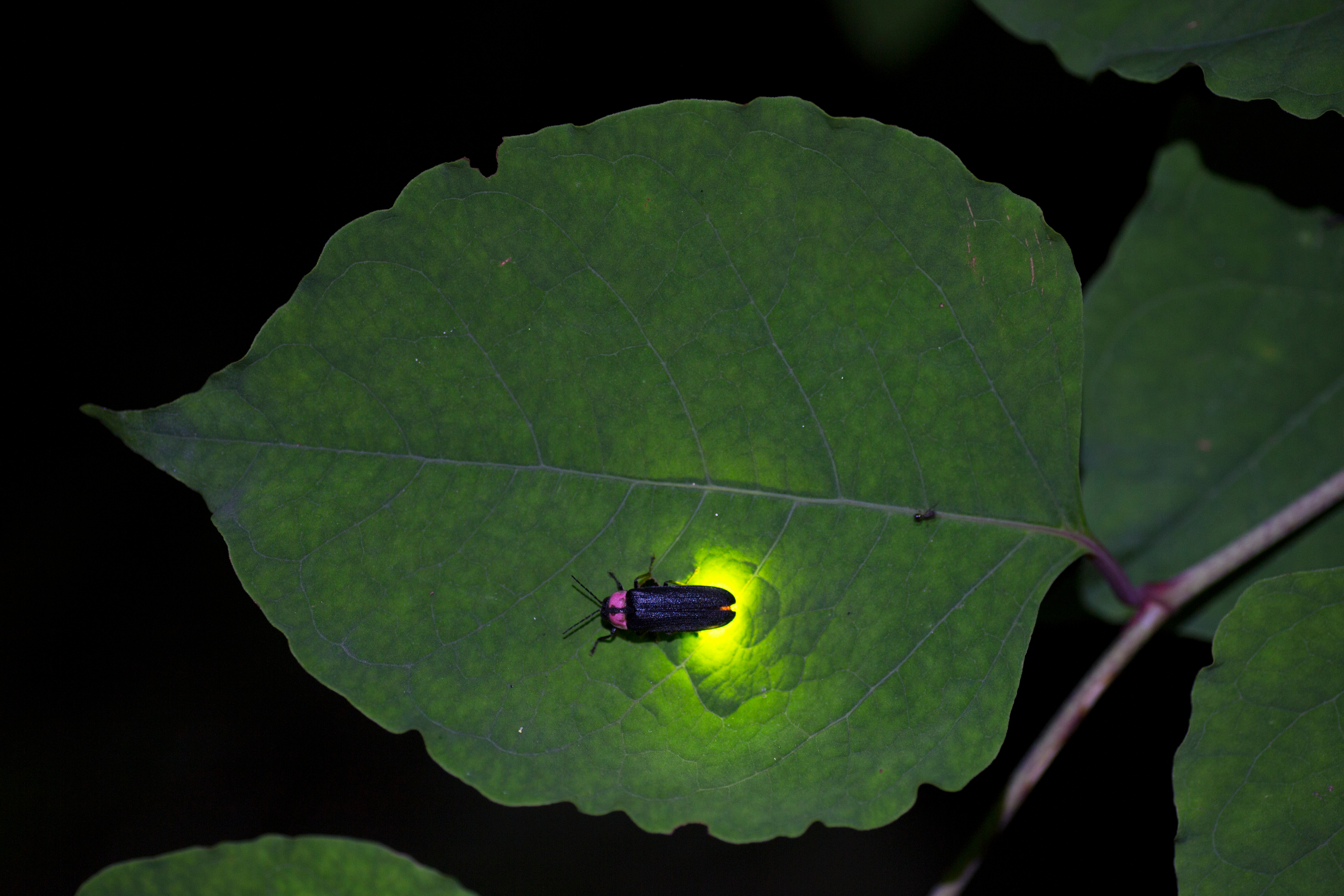Chicago Tribune
For many who grew up east of the Mississippi River, yellow twinkling lights punctuate magical childhood memories. New England natives call them fireflies, but they’re known as lightning bugs from the Midwest to the South. No matter their regional name, they are a staple of warm summer evenings.
Yet concerns about how many more generations will be able to bask in the glow of this nostalgic phenomenon have emerged in recent decades as anecdotal reports and observations in certain locations seemingly indicate firefly numbers are dwindling.
“We kept hearing all these stories that fireflies were in decline, firefly populations were disappearing, and as an invertebrate conservation organization, that always piques our interest,” said Candace Fallon, a senior conservation biologist who has led firefly research in the endangered species program at the Xerces Society since 2018. “So we decided to look into it a little bit more, and started doing formal assessments, building partnerships and working with other researchers, and it’s really grown since then.”
While scientists have long known firefly populations can be influenced by pesticides, artificial lights, soil and weather, a study published last month suggests that human-made climate change may pose an even greater threat than previously thought. The study also predicts that, while numbers might decline for most species with specific habitat needs, certain areas of the country such as the Midwest might experience population growth of some common firefly species as average temperatures become warmer.
“As it turns out, weather and climate appear to be, at least in general, the most important variables for predicting firefly abundance and firefly population status across the eastern United States,” said Darin McNeil, the study’s lead author and an assistant professor of ecology at the University of Kentucky.
Over 2,200 species of fireflies live across every continent in the world except Antarctica. The United States is home to approximately 165 known species; a 2021 study Fallon collaborated in found that at least 18 of 132 surveyed North American species were threatened with extinction and two were near-threatened.
Flashing fireflies are more common across the eastern United States. Other species in the western part of the country don’t light up at night, like daytime dark fireflies, or don’t fly, like glowworms.
Twenty-six species call Illinois home, one of which — the Cypress firefly — is classified as vulnerable in the International Union for Conservation of Nature Red List of Threatened Species.
The common eastern firefly is the most populous east of the Mississippi. It’s also known as the Big Dipper, nicknamed not after the twinkling constellation but because of its flight pattern, which seems to trace the shape of the letter J as it lights up.
“By and large, the Big Dipper is going to be the one — that’s the firefly people think of when you talk about fireflies. It’s out at dusk. It can be in really urban areas, agricultural areas, more natural areas,” Fallon said. “It persists in these highly developed areas, and so that species seems to be doing OK. … But I would hope that people would want to see fireflies of all species persist into the future, right?”
Threats east of the Mississippi
Certain human activities have been known to harm firefly populations. Urban and agricultural development cause habitat loss. Pollution from artificial lights can interfere with their bioluminescent mating and courtship, and farming practices such as the use of pesticides can kill fireflies.
Short-term and long-term weather are also important factors in the distribution of insect populations; for instance, maximum seasonal temperatures and soil moisture from precipitation can predict the abundance of fireflies in a given year.
But McNeil and fellow researchers from Pennsylvania institutions found that climate and weather, and how human-made climate change influences them, have a higher relative importance than previously thought.
By analyzing data collected by thousands of citizen scientists, the researchers trained machines to model different scenarios to understand how various climatic changes — specifically milder winters, hotter summers, and higher frequency of drought and storms — could interact with the other threats and affect flashing firefly populations in the eastern United States. The researchers noted that, based on data from citizen observations, the study results were not parsed by species but generalized.
Their models showed short-term warm periods might lead to temporary higher firefly counts in some places as the insects thrive in high temperatures in later life stages, but long-term warming trends can be negative for younger insects and hurt populations in the long run.
The study concluded the insect’s abundance was “generally, negatively affected” by an increase in summertime heat. However, just as most areas might see a decline in the populations of certain firefly species under climate change or even lose populations altogether, the models indicated conditions, including warmer temperatures, might make some areas able to support larger local and regional populations, primarily around the Midwest and Great Lakes.
“Researchers are always saying there are climate change winners and losers, right?” Fallon said. “Some species are going to benefit from the impacts of climate change, and then others are not, their populations are going to tank. They’re going to lose habitat. And fireflies are no exception.”
Still, conservationists emphasize the need to protect biodiversity to “keep the common species common and protect the ones that are less common,” Fallon said.
Extreme weather events will be unavoidable as they continue intensifying with climate change, McNeil said.
“For instance, periods of drought are probably going to eliminate fireflies, at least for a short period of time, or reduce their abundance in certain areas,” he said. “In their larval stage … they’re very sensitive to desiccation, they can dry out really easily and dehydrate, so they need to have a certain level of moisture at this level of soil. But if there’s a lot of flooding, that’s not good, if you’re a little larva that runs around on the surface of the soil.”
Even if species such as the Big Dipper are considered less vulnerable to climate threats, that doesn’t necessarily mean they are safe from other human-made stressors.
“In places where we have skyrocketing population sizes and developments, those pressures are eventually going to hit a point where (any) fireflies may not be able to cope anymore,” she said.
Charismatic beetles
Fireflies don’t all just fly around — or in the case of glowworms, crawl around — looking pretty. (They are also not considered flies or worms but beetles). Their early feeding patterns play pivotal roles in the ecosystems where they are present. They serve primarily as predators, an ecological function that occurs mainly during their larval stage which lasts up to two years.
“The main job of larvae or juvenile, baby, fireflies is to eat,” Fallon said. “So they spend all their time hunting and looking for things like worms.”
As adults, most firefly species don’t feed at all or eat very little, McNeil said.
“But their larvae are these vicious monsters,” he laughed. “Now, they’re like, less than an inch long, but if you’re a slug, that is like a Bengal tiger to you.”
Scientists have also hypothesized that in agricultural fields, fireflies can help control the pest population of snails and slugs.
“They light up as larvae too,” McNeil said. “They have this really cool life cycle.”
Once adults, not all of these species of beetles continue to be bioluminescent — meaning they produce light with a chemical reaction to attract mates and prey or to deter possible predators — but their larval glow has been studied in medical imaging to map disease in the human body and used for food safety purposes like detecting contamination.
Beyond their ecological and medical value, Fallon said, fireflies are a cultural and aesthetic touchstone.
“They’ve really been valued and celebrated for centuries; they’re the object of all these different types of artwork, writing, poetry, and even plays, dances and festivals,” she said. “I think there’s something about flashing fireflies in particular that really sparks the imagination, and gives people this feeling of wonder and awe and a connection to the environment that a lot of other insects don’t provide.”
Just as the popularity of giant pandas, elephants, koalas and gorillas has made them icons of conservation campaigns and earned them the title of “charismatic megafauna,” insects such as flashing fireflies have a special appeal.
“It’s really easy to see how the loss of fireflies makes your summer night just a little bit less magical,” McNeil said.
Maybe it’s because of their ability to evoke nostalgic memories or because their lights twinkle gently enough for children to put aside fears of insects. Regardless, fireflies are cherished by many and can inspire curiosity and care for other insects, animals and plants.
“You can protect a whole community and all the organisms that live in it by focusing on those really charismatic organisms,” McNeil said. “Fireflies, I strongly suspect, are kind of that cool, charismatic insect that we can use to protect a whole suite of native species.”
How to help
Firefly lovers can help preserve the insects by maintaining native plant species in backyards instead of trying to keep “perfectly manicured lawns” treated with weed killers and pesticides.
“One thing that I like to do is, in the fall when I rake my leaves, I leave them in my yard,” McNeil said. “I rake them around the edges so that the firefly larvae have a place to overwinter and forage in the spring.”
Turning off lights at nighttime can also help fireflies identify potential mates more easily. Participating in citizen science projects such as the Xerces Society’s Firefly Atlas can improve scientific knowledge about where firefly species are abundant and where they are not.
“Take your kids or your nephews, even a friend, maybe go out for a date, take other people with you, and do this firefly survey, or have you and grandma go sit in the backyard and talk about fireflies for 10 minutes,” McNeil said.
These are small but concrete actions that Americans, even where the insects still abound, can do to continue protecting their unique ecological roles and ignite deeper discussion about conservation.
“This is something I struggle with all the time with my work, how to get people … thinking about populations blinking out, in the southern parts of the country or other parts of fireflies ranges, just knowing how special and magical that experience of seeing fireflies is for folks,” Fallon said.
©2024 Chicago Tribune. Visit at chicagotribune.com. Distributed by Tribune Content Agency, LLC.




